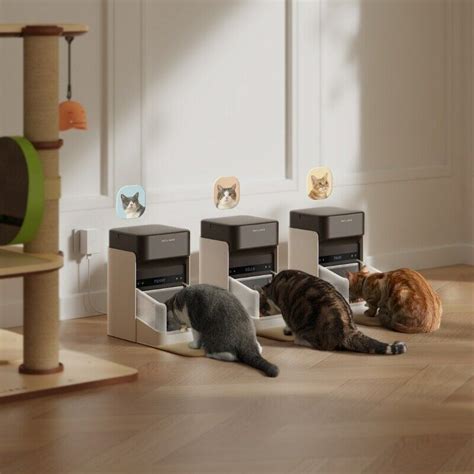Overview
Radio Frequency Identification (RFID) technology is revolutionizing the pet care industry. RFID pet feeders offer unparalleled insights into a pet’s feeding habits, allowing owners to monitor their health and well-being remotely. By 2025, the global RFID pet feeder market is projected to reach $1.5 billion, a testament to the growing demand for these innovative devices.

RFID pet feeders utilize RFID tags attached to a pet’s collar or microchip. When the pet approaches the feeder, the RFID reader embedded in the device identifies the tag and dispenses a predetermined amount of food.
Benefits of RFID Pet Feeders
RFID pet feeders offer numerous benefits compared to traditional feeding methods:
– Remote monitoring: Owners can track their pet’s feeding schedule and food consumption from anywhere with an internet connection.
– Personalized feeding: RFID feeders allow for customized feeding plans based on a pet’s age, weight, and activity level.
– Health monitoring: By monitoring a pet’s feeding behavior, owners can detect any changes in appetite or eating habits that may indicate a medical issue.
– Portion control: RFID feeders help prevent overfeeding and ensure that pets maintain a healthy weight.
– Convenience: RFID feeders eliminate the need for manual feeding, making it easier for owners to care for their pets when away from home.
RFID Pet Feeder VS. Manual Feeding
| Feature | RFID Pet Feeder | Manual Feeding |
|---|---|---|
| Remote monitoring | Yes | No |
| Personalized feeding | Yes | No |
| Health monitoring | Yes | No |
| Portion control | Yes | No |
| Convenience | Yes | No |
Strategies for Effective RFID Pet Feeder Behavior Tracking
To maximize the benefits of RFID pet feeders, owners should implement the following strategies:
1. Establish a regular feeding schedule: This helps regulate a pet’s appetite and metabolism.
2. Use a feeder that dispenses small meals: This prevents overfeeding and reduces the risk of health problems.
3. Monitor your pet’s feeding habits: Track your pet’s daily food consumption and watch for any changes that may indicate a health issue.
4. Use the RFID feeder to track your pet’s weight: Regular weighing helps ensure that your pet is maintaining a healthy weight.
5. Keep the feeder clean: This prevents the accumulation of bacteria that can contaminate food and cause health problems.
Tips and Tricks for Using RFID Pet Feeders
– Choose the right feeder for your pet: Consider your pet’s size, age, and activity level when selecting an RFID feeder.
– Set up the feeder properly: Follow the manufacturer’s instructions carefully to ensure the feeder functions correctly.
– Test the feeder before use: Feed your pet manually while the RFID feeder is operating to ensure that it dispenses food properly.
– Monitor your pet’s appetite: If your pet’s appetite changes significantly, consult a veterinarian to rule out any underlying medical issues.
– Be patient with your pet: It may take some time for your pet to adjust to using an RFID feeder.
FAQs about RFID Pet Feeders
1. How accurate are RFID pet feeders? RFID pet feeders are highly accurate, with a success rate of over 99%.
2. How secure are RFID pet feeders? RFID pet feeders use encryption technology to protect pet data from unauthorized access.
3. Are RFID pet feeders safe for pets? Yes, RFID pet feeders emit low levels of radiation that are harmless to pets and humans.
4. How often should I clean my RFID pet feeder? RFID pet feeders should be cleaned at least once a week to prevent the accumulation of bacteria.
5. Can I use my RFID pet feeder with multiple pets? Yes, some RFID pet feeders can accommodate multiple pets with different feeding schedules.
6. What should I do if my RFID pet feeder is not working properly? Contact the manufacturer of your RFID pet feeder for troubleshooting assistance.
Current Status and Future Trends
RFID pet feeders are rapidly gaining popularity and are expected to become a standard part of pet care in the near future. As technology advances, RFID pet feeders will become even more sophisticated, offering features such as:
– Advanced health monitoring: RFID pet feeders will be able to track a pet’s activity level, temperature, and other vital signs.
– Remote training: RFID pet feeders will be able to dispense treats or play games with pets remotely, providing entertainment and training opportunities.
– Integration with other smart home devices: RFID pet feeders will be able to connect with other smart home devices, such as lights and thermostats, to create a fully automated pet care system.
Conclusion
RFID pet feeders are revolutionizing the way we care for our beloved pets. By providing remote monitoring, personalized feeding, health monitoring, and portion control, RFID pet feeders help owners ensure the health and well-being of their furry friends. As technology advances, RFID pet feeders will become even more sophisticated, offering new and innovative ways to care for our pets.





















